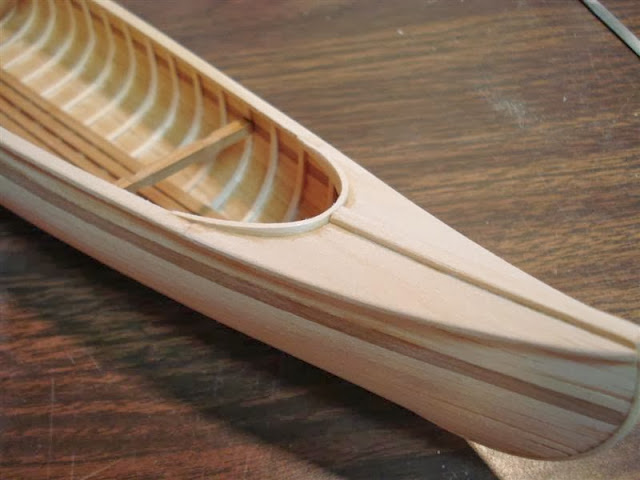The hull is now surprisingly strong for its light weight and will get even stronger once the internal frames are added. Start by milling strips that are 1/16 by 1/32 inch in cross section.

These are soaked and bent over the approximate strongback frames. This will prevent them from kinking when inserted into the hull.
They are placed into the hull while damp and thin CA is used to glue them in place.

A strip of plastic works as a spacer and the frames are glued into place the whole length of the hull.
Once all are in place, trim the ends and sand flush with the sheer plank.
| ||
Three short segments of strip are used to finish off the planking of the stem and stern and a gentle curve is carved and sanded into these strips. The stem and stern pieces are trimmed down and a crown is made into the tops of these.
The decks are glued in place with a slight separation between the deck pieces at the far ends of these. This will be covered by a cap on top and a false keel at the ends.
As can be seen in this photo, there is plenty of excess material for forming the overhang on the hull.
Cap rails are cut and installed between the ends of the decks.
The interface between the cap rails and the decks are cleaned up and a gentle camber is sanded into the tops of the decks.
An even overhang is shaped in the cap rails and decks.
Deck caps are installed and trimmed to size.
Here is a very effective method for soaking wood that works well if you don’t want to get a large container out to hold the planks. If the wood is very stiff and doesn't want to bend well, the water soaked plank/paper towel assembly can be micro-waved to steam the wood. I've used this technique several time with uniformly good success.
The false keel is bent to shape and installed onto the hull using rubber bands attached to the thwarts to hold it in place while the glue dries.
The cockpit combings are formed using a bending jig made of MDF and then are installed into place.
Trim and profile the combings once they are attached to the canoe.
Paddles can be made to accent the canoe display. For this particular canoe I chose traditional otter tail paddles. First find a pattern that you like and size the paddles to an appropriate length. In this case they end up being around 5 inches long. The various stages of production are shown here.
Make a pattern and trace out on basswood, cut out using a new and sharp knife. Use a plane or other tool to thin out the blade of the paddle.
Since I turn out the shafts on a drill press I carve a round section to insert into the drill press chuck. Turn the shaft.
Finish off the hand grip and smooth off the interfaces between the handle, shaft and blade.
Here is a photo of the completed canoes. The one in front has mahogany trim and the one in back cherry. The presentation plate has been placed on the first canoe while the second is still awaiting a suitable event for presentation. I hope that you've enjoyed following along.






















No comments:
Post a Comment